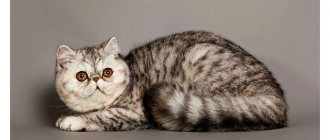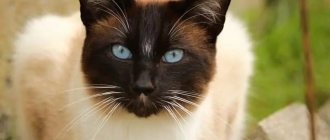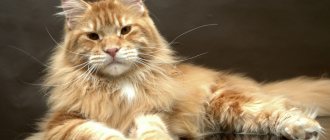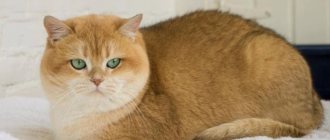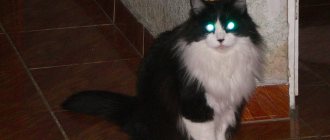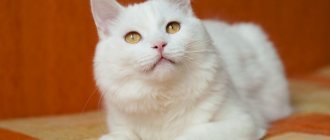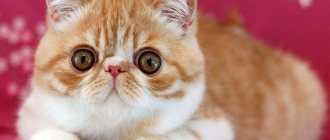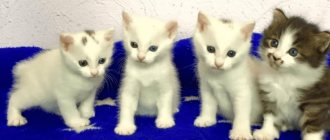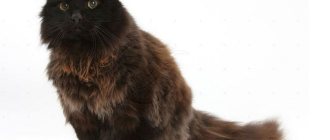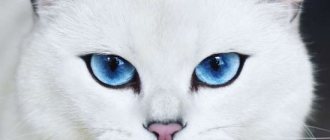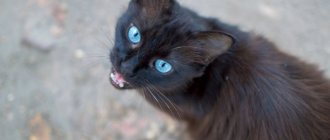The history of flat-faced cats
The domestication of cats occurred about 12 thousand years ago. Back then they were wild animals living in natural conditions. A variety of breeds have begun to appear in the last few centuries. Felinologists were guided by their own vision and created cats with a diverse body structure and coat color.
Cats with a flattened face appeared around 500 BC , at least this fact is attested in written sources and wall paintings. Dutch travelers recorded in their notes that they saw strange cats with fluffy fur at the court of the kings of Persia Cambyses and Darius.
Their attractive appearance made these cats favorites of kings and court nobility . The ancestors of the Persians appeared in Europe in the 16th century. and became loved by the cats of kings. Here cats continued to evolve into the species we see today.
Felinological organizations are responsible for registering new breeds . Thus, out of 200 breeds existing in the world, about 74 breeds have received official recognition. The Persians are just one of them. For example, British cats were previously called shorthaired and were registered as a separate breed only in 1930.
In the 1920s and 1930s in the United States and Sweden, breeders began crossing Siamese and Persian cats. This is how the Himalayan cat appeared. But only in 1980 the breed was officially registered.
In the 60s the 20th century, the Persian and the American Shorthair cat were crossed in the USA. The new breed is called exotic. At first, Murkas frightened breeders with their strange appearance, but nevertheless, the breed became widespread in the USA and other countries of the world. Exotics were officially registered in the 80s.
Scottish cats also have a slightly flattened face, and this breed appeared quite unexpectedly. In the 60s, on a Scottish farm, a cat Susie was born with a gene mutation, which manifested itself in the form of a brachycephalic skull shape and forward-curved ears. At that time, there were no pets with such abnormalities in Scotland, so Susie’s offspring were crossed with the “British”. As a result, it was possible to develop a new breed, which was named after the place of residence of the ancestor.
Scientists explain the unusual shape of the Ford as a genetic deviation . In scientific circles it is called “brachycephaly,” which is translated from Latin as “short head.” In brachycephals, the length of the head is 80% of the width of the skull.
There is another version , according to which the cat inherited this shape of the skull from the Pallas cat. However, the version has no scientific confirmation.
On a note! Breeders worked hard to fix brachycephaly and selected for crossing those individuals whose flattened muzzle was a distinctive feature.
Advantages and disadvantages
Cats with flattened faces look charming and have a number of undeniable advantages :
- Their original and interesting appearance will not leave anyone indifferent. Even with the diversity of cat breeds, brachycephals attract attention.
- Their jaws are stronger than those of cats with a classic muzzle structure.
- Cats are endowed with an affectionate and friendly character . They like to impose themselves and behave with restraint.
The disadvantages relate mainly to physiological nuances:
- For animals you need to select special bowls from which they can get water and food without any problems.
- Cats with a strongly flattened muzzle snore and snort in their sleep . This feature amuses some owners, irritates others.
- Shortened tear ducts and the specific shape of the nose cause excessive tearing and mucus production, which is why some animals experience severe stress.
- Some cats with a similar skull structure cannot feed on their own. Their owners spoon-feed them and care for them like babies.
- Animals suffer from impaired thermoregulation function due to short nasal passages; they have difficulty withstanding low air temperatures, and therefore often suffer from infectious diseases.
- Cats with a flattened nose are more likely to suffer from allergies than others .
Despite all the shortcomings of this type of cat, the popularity of these animals does not decrease. Proper care and following your veterinarian's recommendations will minimize problems that may arise.
Description
Not many people know that of all pets, cats have the largest eyes relative to their overall body size. If we convert human proportions to cat proportions, then humans would have eyes with a diameter of about 20 centimeters. And this takes into account the data of the average cat, and what can we say about big-eyed breeds.
Unlike dogs, cats see the world in different colors, and there are only some colors that they do not distinguish, but this does not interfere with them in everyday life. In poor lighting, the capabilities of their vision are revealed to their full potential, and in pitch darkness, their sense of smell, vision and whiskers help them navigate more. They have a slight farsightedness, but they perfectly capture the slightest movements of objects. A cat's viewing angle is 200 degrees, but a person's is only 180 degrees.
There are various big-eyed cat breeds. Their images simply flooded the Internet, because these charming creatures look even cuter than their tailed relatives. In some people, due to the structure of their eyes, their gaze seems more sly and cunning, while in others it appears meek and even pleading. In general, their eyes most often have a round shape, and the pupils of these cats seem simply huge.
Cat breeds with flat faces
Every year, the CFA Cat Fanciers Association publishes rankings of the most popular cats. The leaders invariably remain cats with flattened faces.
Representatives of each breed are endowed with distinctive features, despite the fact that the shape of the muzzle is almost the same.
Persian
"Persian" - a breed of cats with a flattened muzzle is considered one of the oldest in the world . The history of its development and formation remains to some extent unknown, but most felinologists are of the opinion that the breed originates from Persia. Nowadays it is the territory of Iran and Turkey.
The breed standard has changed slightly during its existence.
Modern Persians look like this:
- massive build;
- developed muscles;
- short legs;
- large spherical head;
- small upturned nose;
- wide-set ears;
- large round eyes;
- bushy tail.
The weight of males is 5-8 kg , females 3-5 kg.
The most common colors : beige, white, gray. The breed standard includes about 100 different colors.
Breeders distinguish three varieties of the breed :
- Extreme - American subspecies with a raised tip of the nose at eye level. The ears are small and drooping, the eyes are round, like saucers.
- Aristocratic or European - a subspecies close to the classic version. The brachycephalic shape of the skull is little noticeable, the muzzle is slightly flattened, and the nose is turned up. The ears are large and straight.
- Classic or British is a subspecies characterized by a straight nose located just below eye level. These cats have luxurious, long hair.
The Persian cat is called a “couch cat” because most of the time she sleeps peacefully in a cozy corner . “Persians” are very well-mannered animals, so owners should not worry about damaged property. Cats are trainable, quite pliable and not picky. Their calm disposition makes them ideal pets for families with children.
Interesting. Queen Victoria kept two blue Persians at court, and Marilyn Monroe had a white Persian cat named Mitsu.
Himalayan
The Himalayan cat is a direct descendant of the Persian, a breed of cat with large eyes and a flattened muzzle . A Siamese cat also took part in the breeding.
Distinctive features of the breed:
- sky blue eyes;
- dark muzzle on a light background (color point);
- pubescent coat;
- short legs;
- large body.
The Himalayans are just as lazy creatures as the Persians. They like to sleep on a soft pillow or sofa most of the time and only occasionally give in to children's persuasion to play with a candy wrapper.
Cats have a calm and balanced disposition . Owners of the breed note that their pets are as apathetic as possible and allow themselves to be cuddled endlessly. Himalayan cats are infinitely devoted to their owners, they love to follow on their heels, bask on their laps and purr.
Representatives of the breed try to avoid emotional shocks, do not like to play pranks , and lead a measured lifestyle. They find it difficult to cope with a change of place of residence and have difficulty adapting to a new place.
Exotic
The exotic is the owner of the most flattened muzzle among its relatives , the result of a merger of the Persian and American shorthair cats.
Distinctive features of the breed:
- large, close-set eyes;
- soft fur;
- short but strong legs;
- wide chest;
- large sizes;
- Various colors - white to black.
The appearance of a flat-faced exotic cat is in harmony with his character. He is soft, flexible, not prone to aggression, and rarely shows dissatisfaction .
Representatives of this breed are more active and inquisitive than Persians. But if the owner encourages laziness and overeating, the pet will turn into a fluffy pillow that will only show signs of life when it’s lunch time.
Reference. Exotics like to sleep on concrete or tiled floors, which is associated with overheating of the body.
Scottish
The Scottish cat is a sweet and affectionate creature with an attractive appearance and docile character .
Distinctive features of the breed:
- rounded head shape;
- powerful neck and chest;
- strong long legs;
- drooping ears in the Scottish Fold variety, straight ears in the Scottish Straight;
- large weight (6-7 kg).
By nature, the “Scots” are calm, balanced and flexible, suitable for families with children . They are kind, friendly and loving. Over time, cats select one favorite among family members and show maximum trust, cordiality and affection towards him.
“Scots” are generally not very active, so breeders recommend stimulating physical activity in pets to prevent weight gain.
Scottish Folds have an innate curiosity, sometimes they get a little impudent and pretend that they don’t understand what they are accused of: “Just think, I ate half a ficus, I just wanted to taste it!”
British
There are two varieties of British cats - longhair and shorthair, but they have the same breed characteristics :
- muscular body;
- large paws;
- rounded head;
- wide-set ears;
- tassel at the tip of the tail.
The colors and coat patterns are varied . The most popular is smoky blue. British cats are long-lived and live up to 22-24 years.
“British women” are kind and friendly, wonderful companions for single people and playful friends for children . Cats are smart and quick-witted, they love to watch what is happening. Interest in games does not disappear with age. Animals need human attention, love to be around, and show a keen interest in what the owner is doing. For example, if he is working on a laptop, the cat can climb out onto the table and sit next to him or even lie down on the keyboard.
Manul
The wild cat Pallas is considered the progenitor of all breeds with a flattened muzzle. The animal lives in Central Asia, differs little in size from the average domestic cat, but has “predatory” characteristics :
- massive, squat body;
- short legs;
- thick fur;
- flat skull;
- powerful jaws;
- frown;
- tufts of long hair on the cheeks;
- yellow iris;
- always round pupils, regardless of the brightness of the light;
- light gray and fawn-ocher color, hairs with white tips;
- striped pattern that helps camouflage in the wild.
Reference. Pallas' cats are listed in the Red Books of Russia, China, Kyrgyzstan, Kazakhstan, and Mongolia.
Persian
Long silky hair (of any color), round green or yellow eyes, a flattened muzzle with an upturned nose - these are the characteristic features of a purebred Persian. His character can be either capricious or pliable, calm.
Thanks to the long, thick fur, the size of the Persian cat visually increases, but after a bath you can be very surprised by the size of the pet, because they will be much smaller than it seems.
Among the representatives of this cat breed there are also their own types:
- Classic (nose slightly below the eye line).
- European (the edge of the nose is at the same level as the lower eyelid).
- Extreme (nose in line with the inner corners of the eyes).
Features of care and susceptibility to disease
Gene mutations in brachycephalic cats cause breathing problems . Both kittens and adult cats often snore in their sleep and smack their lips while eating. They suffer from upper respiratory tract infections more often than other breeds and experience discomfort associated with increased lacrimation due to their close-set eyes. When you have a cold, the conjunctiva becomes inflamed and purulent discharge is observed.
Flat-faced felines are susceptible to allergic reactions to pollen and dust .
The diet of brachycephals should be balanced and varied . Breeders note that they are extremely demanding on the quality of food and prefer dry or wet premium and super premium food, natural food - poultry, white fish, fresh vegetables and herbs. Animals often have digestive problems, so they should not be fed food from the table, given whole cow's milk, sweets, or smoked meats.
Caring for cats with flat fashion is not burdensome, but requires compliance with a number of rules:
- animals must be protected from frost, drafts and temperature changes;
- feed with premium food;
- clean your eyes daily with alcohol-free wet wipes or cotton pads soaked in clean water or tea leaves;
- Inspect and clean the ears once a week; cleaning ears for folds is especially important;
- Visit your veterinarian regularly to watch for breathing problems that develop in older animals.
These rules will help keep your pets healthy and minimize problems associated with brachycevalia.
Keeping puppies
All breeds with flattened muzzles were bred artificially; targeted selection reinforced the desired trait.
The result was a modified shape of the skull, which entailed both positive and negative results. All breeds suffer from specific health problems and therefore require special care. The structural features of the respiratory tract make it difficult to inhale and exhale. Representatives of the breed may feel worse as a result of a congenital mutation that is not provided for by the standard. Dogs may suffer from heart failure due to increased pulmonary artery pressure
It is important that one minor problem can lead to quite life-threatening diseases. The characteristics of the breeds must be taken seriously
Protect your dog from extreme heat, exercise, and stress.
If the heart rate increases, you should immediately calm the animal. In this condition, the body requires more oxygen. Air flows in only in limited quantities due to the narrow airways. As a result of prolonged stress, the animal may lose consciousness. If the animal is still small (up to 1.5 years), then it is worth protecting it from any stressful situations.
It is worth monitoring the weight of a dog with a flattened muzzle. If an animal is obese, it gets tired faster and feels worse in the heat. All this negatively affects breathing. Puppies should be fed on a schedule and in doses recommended for the dog’s age.
This rule is especially important for pugs who have a very good appetite and do not like active games.
Choose the right collar so that it does not squeeze your throat. It is generally recommended to use a harness for walking. Do not make sudden jerks with the leash, which could result in choking, loss of consciousness, or even death. During hot summers, it is worth reducing the number of walks. Take your dog outside only early in the morning and in the evening when the air temperature drops.
Special rules for keeping flat-faced dogs include a number of nuances.
- It is necessary to visit the veterinarian annually for consultation. The examination should include not only external diagnostics, but also an ultrasound of the heart, x-rays, examination of the larynx, and listening to the condition of the lungs and heart. Such measures will help detect diseases or pathologies in the early stages.
- It is worth contacting a specialist if the animal makes uncharacteristic sounds or has changed significantly in its habits.
- Regularly inspect the condition of the ears, eyes, folds near the nose and the respiratory canals themselves.
Brachycephalics cannot fly on an airplane - it is contraindicated for them. Changes in pressure, heat, stress can lead to the death of a pet. Moreover, it is quite hot on board an airplane, which also leads to heat stroke. If you are planning a trip, make sure you have someone at home to look after your dog.
Watch the video below for veterinarians' opinions on dogs with flat faces.
